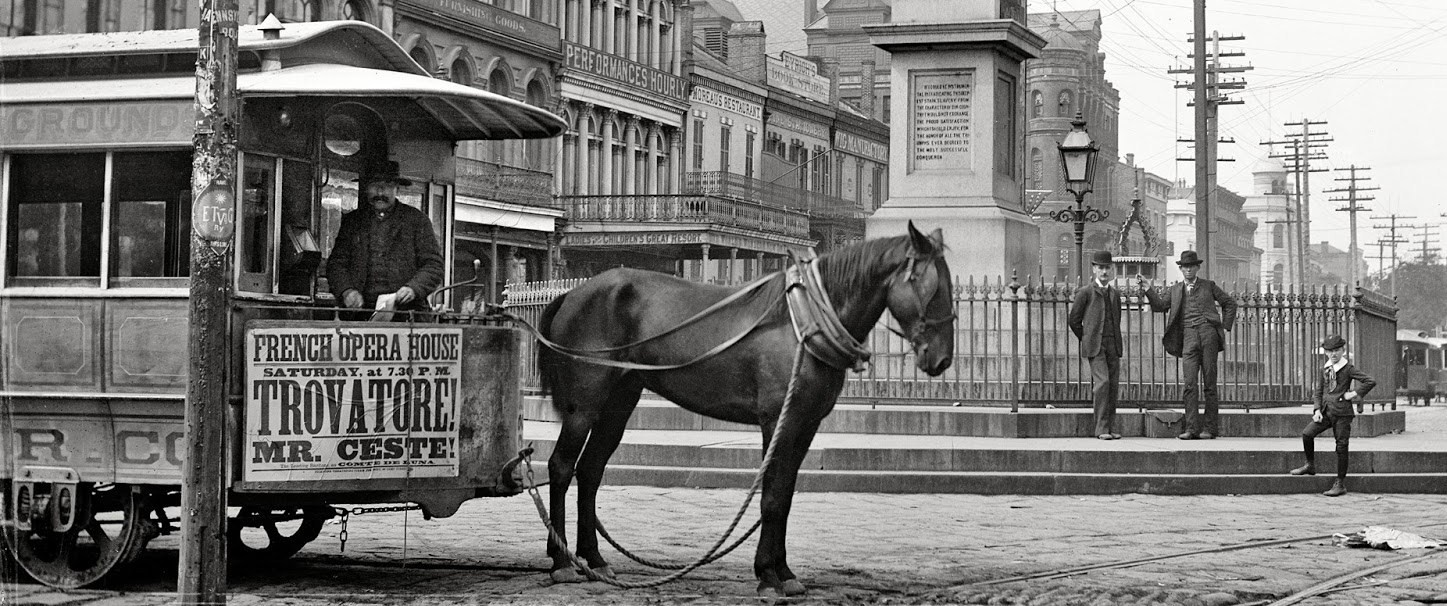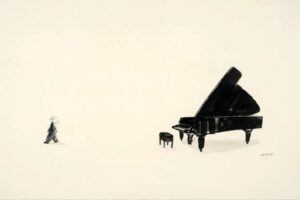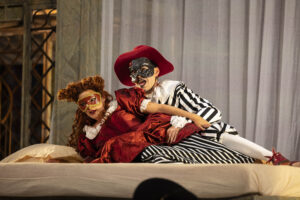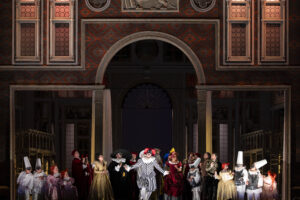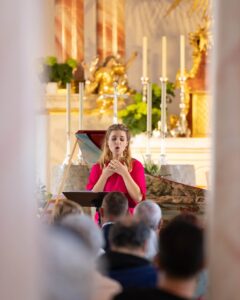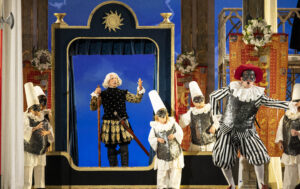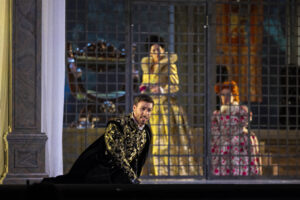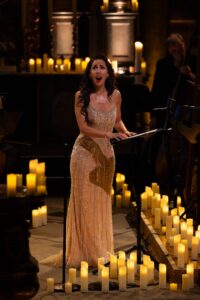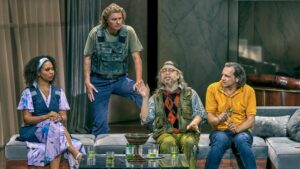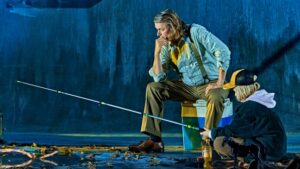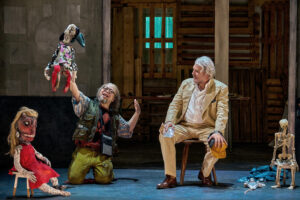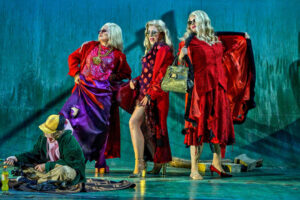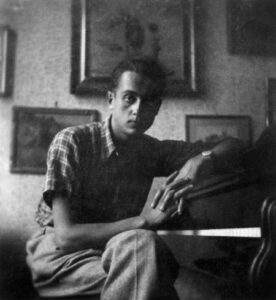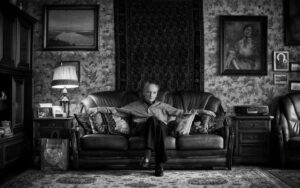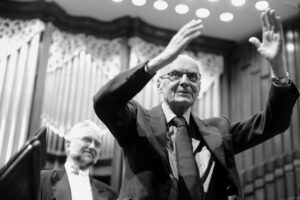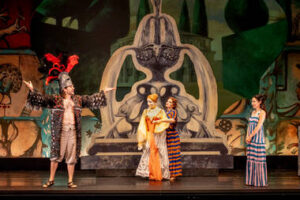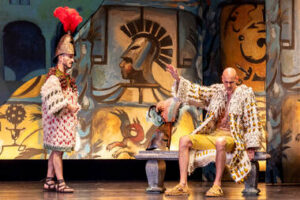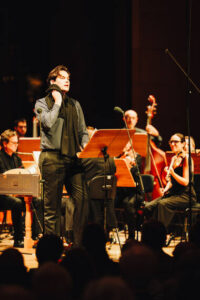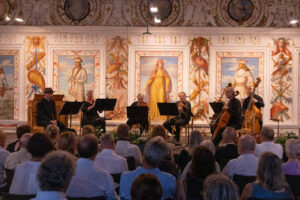Dziś będzie wspomnienie nietypowe, bo nadarzyła się nietypowa okazja. Nakładem Fundacji Bęc Zmiana ukazało się właśnie Strojenie świata R. Murraya Schafera w przekładzie Krzysztofa Marciniaka – przyjaciela Upiora i wszystkich moich poprzednich wcieleń krytyczno-pisarskich. Wydawca pisze o książce, wydanej po raz pierwszy w Kanadzie i Stanach Zjednoczonych w 1977 roku, że to „pozycja obowiązkowa dla wszystkich osób zainteresowanych ekologią dźwięku, współczesnym i historycznym sound designem, ale też projektowaniem przyjaznych przestrzeni i problematyką zanieczyszczenia dźwiękiem. To właśnie R. Murray Schafer jest twórcą chętnie używanego dziś pojęcia 'pejzażu dźwiękowego’ i autorem wielu praktycznych ćwiczeń ze świadomego słuchania”. Krzysztof napisał mi wczoraj, że to „jeden z najważniejszych traktatów kompozytorskich XX wieku, otwierający muzykę na totalne myślenie o dźwięku, całym wszechświecie dźwiękowym jako gigantycznej kompozycji muzycznej, z jej logiką, instrumentacją, formą, rytmami, przebiegiem czasowym, motywami. Tekst o potężnym znaczeniu kulturoznawczym, bo kształtuje podstawy współczesnych nauk o dźwięku. Wreszcie – co dla mnie, tłumacza, chyba radość największa – jest to partytura tekstowa do wykonywania w wyobraźni, bo czyta się o tych wszystkich dźwiękach i odtwarza je mimowolnie w głowie”. Oficjalna premiera książki odbyła się dziś w Domu Kultury Śródmieście, jako wydarzenie towarzyszące Warszawskiej Jesieni. A mnie się przypomniało, kiedy Krzysztof po raz pierwszy podzielił się ze mną zachwytem Strojeniem świata. Było to czternaście lat temu z okładem, w Berlinie, na dziesiątym festiwalu MaerzMusik, niewątpliwie inspirowanym pracą Schafera. Pisałam o tym jak zwykle do „Ruchu Muzycznego”, wcześniej jednak dzieliłam się wrażeniami z młodszymi kolegami po fachu: Moniką Pasiecznik i właśnie Krzysztofem. Proszę potraktować mój tekst jako dodatkową zachętę do zakupu tej wyjątkowej książki.
***
Aż wierzyć się nie chce, że to już po raz dziesiąty. Zakrojony z rozmachem festiwal muzyki nowej toczy się od dziesięciu lat według autorskiego pomysłu jednego człowieka, który przyszedł tu wprost ze stowarzyszenia Freunde Guter Musik Berlin i na dobrą sprawę przeniósł jego program i metody działania na imprezę organizowaną pod egidą Berliner Festspiele. A było co naśladować. W 1984 roku, kiedy w Polsce panowała najczarniejsza noc beznadziei, na berlińskim Kreuzbergu Arditti Quartet grał Ivesa, Cage’a i Scelsiego, a Robert Ashley pokazywał swoją operę multimedialną Atalanta. Od roku 2002, w którym ruszył festiwal MaerzMusik pod dyrekcją Matthiasa Osterwolda, w stolicy Niemiec rozbrzmiewa muzyka ściśle osadzona w kontekście – geograficznym, pokoleniowym, przestrzennym – nie zawsze jednak będąca muzyką samą w sobie. Jednych to drażni, innych zachwyca. Być może wkrótce zamienią się rolami. W tym roku świętowaliśmy jubileusz Marcowej Muzyki. Niewykluczone, że przyszłoroczna będzie ostatnią firmowaną przez Osterwolda. Centrum sztuki Berliner Festspiele zmienia dyrektora i trudno przewidzieć, czy nowy zgodzi się na kontynuację Festiwalu w dotychczasowym kształcie.
A tegoroczny chyba jeszcze bardziej przypominał dawne przeglądy Freunde Guter Musik. W związku z trwającym remontem Haus der Berliner Festspiele Osterwold wyprowadził go radykalnie w przestrzeń miejską, praktycznie zrezygnował z przedstawień teatru muzycznego i zastąpił je seansami filmowymi. Wszystko pod wyjątkowo tym razem celnym hasłem „Klang Bild Bewegung” („dźwięk obraz ruch”). Dźwięki otaczały nas zewsząd, obrazy migotały jak w kalejdoskopie, ruch trwał bezustannie, i tylko muzyki jakby zabrakło. O dziwo, wcale mi to nie przeszkadzało – przez dziesięć dni nurzałam się w rozmaitych przejawach fali akustycznej, obserwując jej głośność, barwę i wysokość, nie próbując wszakże jej analizować. Maerzmusik 2011 dało mi okazję do podsumowań kilku innych nurtów w twórczości minionego stulecia. Mogłam na chłodno zrewaluować futurystyczne spojrzenie w przyszłość i szyderstwo z tradycji. Mogłam porównać język kina niemego w Niemczech, Japonii, Francji i Związku Radzieckim. Mogłam spokojnie się zastanowić nad koncepcją Osterwolda i dojść do wniosku, że nigdy nie chodziło mu o muzykę samą w sobie. Przynajmniej nie taką w akademickim, estradowym tego słowa znaczeniu. Osterwold od początku chciał dowieść, że człowiek współczesny grzęźnie w ruchliwej magmie szumów, alikwotów i hałasów, z której muzyka wyłania się sporadycznie, za to w najmniej oczekiwanych chwilach. Chciał nas uwrażliwić na cud zwany muzyką, żeby wzbudzał tym większą radość. No i znów mu się udało.
Trochę szkoda, że pierwszy cud stał się już w dniu otwarcia. W nieustannie rozwijanym przedsięwzięciu Chroma angielska kompozytorka Rebecca Saunders bada zależności między dźwiękiem a przestrzenią, publicznością a wykonawcami, tytułową barwą a tłem. Pięć grup instrumentalnych zespołu musikFabrik, dziesiątki najprzeróżniejszych pozytywek i kilka innych obiektów dźwiękowych (między innymi gramofon odtwarzający w zablokowanej windzie płytę z pieśniami hiszpańskiego buntownika Paco Ibáñeza) umieszczono w przepastnych wnętrzach Café Moskau, niegdysiejszej chluby gastronomii NRD, po zjednoczeniu Niemiec przerobionej na klub, teraz – po gruntownym remoncie – udostępnianej jako centrum konferencyjne. Zgodnie z założeniem Saunders część muzyków bacznie obserwuje szlaki wędrówek słuchaczy i podąża ich tropem, a dźwięk faluje w przestrzeni, zmienia kolor, krąży w amfiladzie sal restauracyjnych, ewokując nastrój smutku i nostalgii. Muzyka Angielki jest przeraźliwie namacalna – Saunders eksploruje fizyczne właściwości fal akustycznych, ich barwę, drogę załamania w zależności od tworzywa, od którego dźwięk się odbije. Słuchacze „dotykają” tych struktur – trochę spod znaku introwertycznej twórczości Rihma i innych niemieckich nowych subiektywistów – zderzają się z nimi i kształtują jak miękką rzeźbę. Część drepcze w kółko, część siada na podłodze i czeka, aż muzyka sama do nich przyjdzie, część wsłuchuje się z niedowierzaniem, jak odgłosy blisko stu pozytywek wygrywających kołysanki zlewają się w barwną, rozedrganą chmurę dźwiękową. Kiedy chimeryczny utwór dobiega końca, większość kaprysi jak dziecko i próbuje zadekować się w kącie, żeby wysłuchać go „na gapę” na kolejnej prezentacji, przewidzianej po krótkiej przerwie. Festiwal otwarty. Przeczuwamy, że tym razem będzie inaczej.
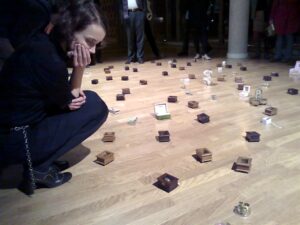
Chroma Rebekki Saunders w Café Moskau. Fot. Dorota Kozińska
Niektóre przedsięwzięcia odrobinę zawiodły nasze nadzieje. Na przykład Tiere sitzen nicht, potężna instalacja Enno Poppego w Radialsystem V. Zgodnie z tytułem, zwierzęta nie siedziały – przeciwnie, członkowie musikFabrik zwijali się jak w ukropie, grając w sumie na 200 instrumentach (albo czymś, co przy odpowiedniej dozie dobrej woli mogło za nie uchodzić) – im mniej zgodnych z ich codziennym emploi koncertowym, tym lepiej. Miał to być modelowy przykład muzycznej sztuki konceptualnej, swoistej Augenmusik, w równej mierze komponowanej, jak improwizowanej: przed ubiegłorocznym prawykonaniem w Kolonii Poppe pracował z zespołem kilkanaście miesięcy, zanim dzieło w miarę okrzepło. W całym tym rozgardiaszu – wśród zgiełku garnków, szklanych kulek, gitar-zabawek i potrzaskanych syntezatorów – najciekawiej zabrzmiały fragmenty dopracowane w szczegółach, choćby początkowy dialog perkusji z pulsującym rytmem urządzeń elektronicznych. Radosna improwizacja muzyków – oparta już to na stojących dźwiękach jakiejś trąbki, pompki i lewarka, już to na quasi-jazzowych rytmach równie egzotycznie dobranej sekcji instrumentalnej – bywała wprawdzie nieodparcie śmieszna, zostawiła jednak po sobie wrażenie nie tyle zabawy, co sztubackiego wygłupu. Jeśli intencją Poppego było stworzenie muzycznej namiastki zwierzyńca, cel został osiągnięty w pełni. Szkopuł w tym, że lisy zbyt często lądowały na jednym wybiegu z kurami.
Innego rodzaju rozczarowanie przyniosły próby wskrzeszenia muzycznych ideałów futuryzmu. Koncert orkiestry intonarumori – generatorów szumu, zrekonstruowanych pieczołowicie według szkiców i notatek Luigiego Russolo – przypominał bardziej pokaz w skansenie niż występ zawodowych muzyków. Szef zespołu Luciano Chessa, ponoć jeden z najwybitniejszych specjalistów od włoskiego futuryzmu (oraz jego rzekomych związków z myślą inżynierską Leonarda da Vinci), zamówił kilkanaście utworów u kompozytorów współczesnych, z których żaden – może z wyjątkiem Margareth Kammerer, śpiewaczki jazzowej i uczennicy współpracujacej ze Scelsim Michiko Hirayamy – nie podjął nawet próby wniknięcia w istotę Russolowskiej sztuki hałasu. Nie pomogły występy gwiazd – basa Nicholasa Isherwooda i Bliksy Bargelda, charyzmatycznego wokalisty Einstürzende Neubauten – nie pomogły wygłupy Amelii Cuni i Wernera Drauda, którego instrumenty z doniczek i rur hydraulicznych tyle mają wspólnego z założeniami futuryzmu, co teksty Nergala z poezją Brunona Jasieńskiego. Zagrany na zakończenie minutowy fragment z Risveglio di una città Russolo zabrzmiał na tym tle dziwnie świeżo – warto chyba głębiej pogrzebać w archiwach.
Nie było też skandalu na wyszukanym obiedzie futurystycznym, który zaserwował przed koncertem szef kuchni Radialsystem V – Johannes Emken, z wykształcenia kulturoznawca. Było smacznie i dziwnie, ale wbrew pozorom daleko od założeń manifestu La cucina futurista Filippa Tommasa Marinettiego. Inna sprawa, że gdyby za cenę 35 euro zabrano gościom sztućce i podano na stół mortadelę z nugatem, wynikły stąd skandal mógłby zagrozić przyszłości Festiwalu.

Dłoń Moniki nad skąpanym w niebieskim świetle futurystycznym stołem w Radialsystem V. Fot. Dorota Kozińska
Większego szoku spodziewałam się po koncercie filharmonicznym zespołu Alarm Will Sound, który słynie z nonszalanckich, przerysowanych i ponoć wirtuozowskich interpretacji muzyki dawnej i współczesnej. Członkowie ansamblu to stworzenia prawdziwie wszystkożerne: równie swobodnie poruszają się w świecie jazzu, improwizacji, popu i world music, jak w twórczości kompozytorów najnowszych. Czasem zbyt swobodnie, czego skutkiem liczne fałsze i usterki rytmiczne, nad którymi dyrygent Alan Pierson zapanować nie umiał i nawet niespecjalnie się starał. Dowland Remix (Flow My Tears) Johna Orfe’a mógł istotnie wstrząsnąć, zwłaszcza wielbicielami mistrza angielskiej lutni, za to aranżacje utworów Apheksa Twina zabrzmiały dziwnie zachowawczo, Birtwistle i Adams przemknęli bez echa. Zaciekawiła jedynie kompozycja Will Sound Rihma, ale długo się jej nie nasłuchaliśmy, bo trwa zaledwie pięć minut – jak prawie wszystkie pozycje w programach orkiestry kameralnej z Rochester.
Opinie bardzo się spolaryzowały po wysłuchaniu TablesAreTurned, wspólnego przedsięwzięcia austriackiego kompozytora Bernharda Langa oraz angielskiego turntablisty i multimedialisty Philipa Jecka (także w sali Filharmonii). Wbrew wielu odniosłam wrażenie, że twórcy poczuli się nawzajem skrępowani swoją wyobraźnią: Jeck potrafi dyrygować całymi „orkiestrami” starych gramofonów, Lang umie zapętlić narrację snutą przez żywy zespół muzyczny i uczynić z niej przedmiot swoistej żonglerki samplami. Niestety, gęsta i ruchliwa tkanka instrumentalna w doskonałym wykonaniu zespołu Alter Ego zderzyła się z rozwlekłością remiksów Jecka. Materiał, którego z powodzeniem starczyłoby na piętnastominutową kompozycję, rozrósł się w ponadgodzinny zakalec, w którym mnóstwo intrygujących pomysłów Langa padło ofiarą wtórnych w gruncie rzeczy wstawek turntablisty.
Miejsce teatru muzycznego zajęły w tym roku trzy przedsięwzięcia multimedialne, zrealizowane w Sophiensaele siłami naszych północnych sąsiadów z Finlandii i Litwy. Moim zdaniem wszystkie trzy nieudane – począwszy od infantylnego monodramu Nothing to Declare Perttu Haapanena, opowieści o zgubnych skutkach rutyny, w brawurowym skądinąd wykonaniu Christopha Isherwooda i towarzyszących mu trzech instrumentalistów, przez ociekające fałszem Lelele Lotty Wennäkoski, czyli koniunkturalną przypowieść o seksualnych niewolnicach z Bałkanów (przeciętna sopranistka Pia Freund, dobry Plus Ensemble), aż po przeraźliwie nudne, utrzymane w duchu litewskiego minimalizmu i repetytywizmu Sandglasses Justé Janulyté. Te ostatnie rozjuszyły mnie osobliwie, bo rzadko się zdarza, by rzecz tak misterna w zamyśle (amplifikowana muzyka w wykonaniu czworga wiolonczelistów zamkniętych w przeźroczystych, sięgających nadscenia tubach, projekcje świetlne, wideo i elektronika) okazała się w rezultacie pusta jak wydmuszka. Cóż, kwestia gustu, byli i tacy, którym się bardzo podobało.
Koncerty muzyki „czystej” były na tegorocznym festiwalu taką rzadkością, że witaliśmy je z szerokim uśmiechem zachwytu. Wspaniałych przeżyć dostarczyło popołudnie z Quatuor Diotima w Sophienkirche, na którym zabrzmiały utwory Aureliana Cattaneo, Ondřeja Adamka, Toshio Hosokawy i Jonathana Harveya. Warto było choćby ze względu na wzorcową interpretację III Kwartetu Harveya – olśniewająco delikatną, precyzyjną w najdrobniejszych szczegółach formy, od ekspozycji głównego tematu, przez kulminację, wprowadzenie tematów pobocznych aż po quasi-taneczny finał. Doskonale słuchało się też Blossoming Hosokawy, kompozycji przejrzystej jak woda, a zarazem ulotnej jak zapach – jakże typowe dla tego twórcy połączenie wschodniej, buddyjskiej duchowości z zachodnim modelem wrażliwości na dźwięk.
Zapadło mi też w pamięć ostatnie niedzielne popołudnie w Radialsystem V, a to za sprawą urodzinowego koncertu Helmuta Lachenmanna z udziałem Trio Accanto. Oprócz wdzięcznego Für Walter Hosokawy (z dedykacją dla Waltera Finka, założyciela Rheingau Musik Festival, który w ubiegłym roku skończył 80 lat) i Gegenstück Rihma (zagranego dwukrotnie, bo saksofonista się pogubił – brawa dla muzyków, za szacunek dla kompozytora i dystans do samych siebie), zabrzmiały jeszcze durch Marka Andre i GOT LOST Lachenmanna. Kompozycja Andre na saksofon, fortepian i perkusję przywodzi na myśl muzyczną akwarelę – nakładanie na ciszę kolejnych warstw laserunku z coraz bardziej przymglonych barw, brzmiących chwilami jak u Sciarrina. GOT LOST – pierwszy utwór Lachenmanna na głos z fortepianem – oślepia z kolei feerią jaskrawych kolorów, rzucanych na tło krótkimi, nerwowymi pociągnięciami muzycznego pędzla. W partii solowej – złożonej z trzech tekstów w trzech językach (Nietzsche, Pessoa i anonimowe ogłoszenie po angielsku o zagubionym koszu na bieliznę) kompozytor zawarł esencję swojego stylu: nagłe skoki interwałowe, dźwięki nieokreślonej wysokości, okrzyki, syknięcia, klaśnięcia językiem i inne efekty perkusyjne. Na pograniczu wykonalności, a jednak wykonane z zegarmistrzowską precyzją przez sopranistkę Sarah Marię Sun. Można tej muzyki nie lubić, zżymać się na jej suchość i pierwotność, nie sposób jednak pominąć jej milczeniem, zwłaszcza w tak mistrzowskiej interpretacji. Jeden z najporządniejszych – w dobrym tego słowa znaczeniu – koncertów Festiwalu.
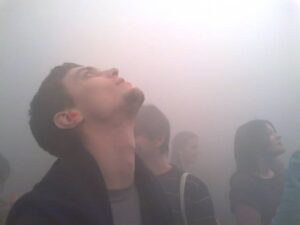
Krzysztof słucha mgły w klubie Berghain. Fot. Dorota Kozińska
Z tego nurtu warto jeszcze wspomnieć – choć już bardziej z kronikarskiego obowiązku – o dobrym recitalu fortepianowym Ralpha van Raata w Universität der Kunste (Harvey, Pei-Yu Shi, Lindberg) i o niezbyt ciekawym wieczorze muzyki kompozytorek (znów Pei-Yu Shi, Elena Mendoza, Jennifer Walshe, tamże). Przyznam się bez bicia, że po dziesięciu dniach festiwalowej krzątaniny zaspałam na poranny przegląd twórczości Kena Ueno z udziałem Heather O’Donnell, Kim Kashkashian, Robyn Schulkowsky i ensemble unitedberlin (Jüdisches Museum). I żałuję do dziś.
Na osobną wzmiankę zasługuje pomysł przedstawienia czterech arcydzieł kina niemego w nowej, wykonywanej na żywo oprawie muzycznej (we Volksbühne i kinie Babylon). Dla kinomana gratka niebywała – Metropolis Fritza Langa w najnowszej rekonstrukcji wzbogaconej o kilkadziesiąt minut ujęć; pierwsza, nieudźwiękowiona wersja antywojennej epopei Oskarżam Abla Gance’a; zupełnie nieznany w Europie melodramat Taki no shiraito z wczesnego okresu twórczości Kenjiego Mizoguchi i propagandowy radziecki film dokumentalny Jedna szósta świata w reżyserii Dżigi Wiertowa, szefa grupy Kino-Oko – notabene urodzonego jako Dawid Kaufman polskiego Żyda z Białegostoku. Dla krytyka muzycznego twardy orzech do zgryzienia, bo nie bardzo wiadomo, jakie przyjąć kryteria oceny. W przypadku Metropolis Martin Matalon postanowił stanąć w radykalnej opozycji do oryginalnej ścieżki Gottfrieda Huppertza. Amplifikowany i przetworzony elektronicznie dźwięk Ensemble Modern nie współgra z filmem, ale też z nim się nie kłóci. Muzyka Matalona zachowuje dystans, raczej odwraca uwagę widza niż skupia ją na obrazie, zamiast potęgować jego ekspresjonizm, próbuje go odrealnić. Zupełnie inną drogą poszli Gary Lucas, legendarny gitarzysta amerykański, i młody kompozytor holenderski Reza Namavar, którzy z zespołem unitedberlin opatrzyli trzygodzinny film Oskarżam fantazją na tematy własne – inspirowaną bluesem, jazzem, Bachem, psychodelią, Paddingiem i Bóg wie, czym jeszcze. O dziwo, z niezłym efektem – stworzyli bowiem współczesny ekwiwalent taperki, która rządziła w niemym kinie, dopóki miejsca pianistów z baru nie zajęły małe orkiestry, a w tańszej wersji – ustawione za kotarą patefony. Misato Mochizuki zdecydowała się na subtelną ilustrację muzyczną, rozpisaną na mały zespół, także japońskich instrumentów tradycyjnych (Nieuw Ensemble) i elektronikę. Tylko Michael Nyman zepsuł mi wieczór w starym kinie, opatrując film Wiertowa jednostajną, przeraźliwie głośną i niemuzykalną łupaniną, której nawet nie muszę opisywać, bo brzmiała tak samo, jak zawsze. Za co ją słusznie wybuczano, choć niejednogłośnie.
Nocne wydarzenia Maerzmusik znów muszę opisać pobieżnie, choć tym razem było jak w Klubie Wynalazców „Młodego Technika”, gdzie przedstawiano pomysły zwariowane, genialne i takie sobie, które zawsze wyglądały lepiej na papierze niż w praktyce. I tak na przykład z twórczego rozwinięcia teorii percepcji psychoekologicznej Jamesa J. Gibsona zostało mi kilka fajnych zdjęć w sztucznej mgle z dymiarki, wspomnienie największych głośników, jakie w życiu widziałam, i komplet zatyczek do uszu, które w końcu okazały się niepotrzebne (Conflux Yutaki Makino w klubie Berghain). Pamiętam, że bardzo mi się spodobało żywiołowe, pulsujące organicznym rytmem Licht – Zeiten Michaela Wertmüllera w wykonaniu Steamboat Switzerland i ze skierowanymi wprost na publiczność projekcjami Lillevana; nie zapomnę, że na unitxt/univrs Alva Noto było naprawdę głośno i kolorowo (oba koncerty w klubie TRAFO). Pokładałam się ze śmiechu na What Got You Here, Won’t Get You There, instalacji Islandczyka Egilla Sæbjörnssona z wykorzystaniem dźwięków, obiektów i wideo – poetyckiej, czarodziejskiej, a przy tym nieodparcie zabawnej (Hamburger Bahnhof). Z zainteresowaniem obejrzałam dokument We Don’t Care About Music Anyway, poświęcony japońskiej scenie alternatywnej.
Muzyki samej w sobie jak na lekarstwo, za to muzyki osadzonej w najrozmaitszych kontekstach kulturowych – dopowiadającej, odwracającej uwagę, pomagającej zapomnieć, rodzącej sprzeciw, kołyszącej do snu i rezonującej w trzewiach – całe mnóstwo. Po kilku dniach w Berlinie strzygliśmy uszami jak króliki: szukaliśmy tonów składowych w odgłosach kolejki miejskiej, rozpoznawaliśmy rowery po ćwierkaniu szprych, podkładaliśmy słowa pod łopot flag na parkingu przy dworcu. Wszystko było widać. Wszystko było słychać. Wszystko się ruszało.
